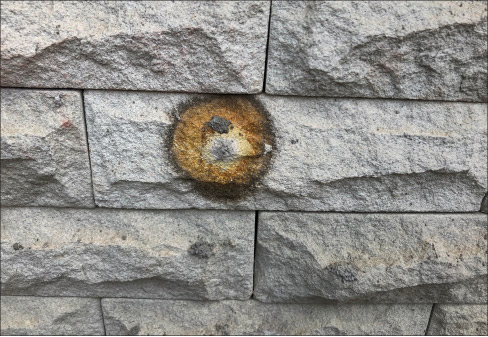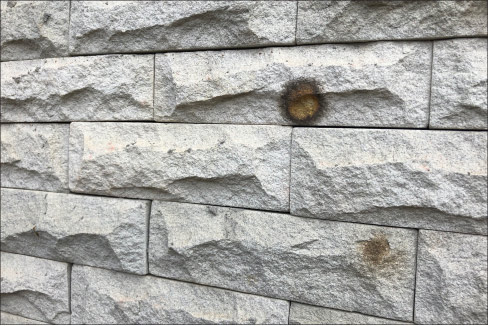The Stone Detective: There’s a Fungus Among Us
Frederick M. Hueston, PhD
I was just getting ready to board the plane for my yearly vacation. This year I was headed to Niagara Falls, then through New York State, and then off to tour some of the stone quarries in Vermont. That’s right folks, I still get to do stone stuff while on vacation. I’ll most likely do a podcast of the quarry tours, so make sure to listen to my podcasts at blogtalkradiol.com/drfred.
I had just found my seat on the plane when my phone rang. The voice on the other end was hard to understand. She was what I call a whisperer. I thought at first it was the phone reception, but she was almost whispering. She started telling me about a strange orange stain she had on a granite façade she had installed recently. I had to ask her to please speak up several times, and was beginning to get frustrated. Finally, I told her to send me an email as I was having a hard time hearing her. I hung up the phone and made a mental note to have my hearing checked. They say these are the “golden years.” Well, you could have fooled me. These days, I spend a lot of time thinking about the hereafter… I go somewhere to get something, and then wonder what I’m hereafter – LOL!
 |
 |
|
These odd orange blossoms of stain show the presence of iron oxidation. Iron is naturally present in many stones, including limestone, like this exterior façade. |
I no sooner had landed, and my phone already had ten voice mails on it! You guessed right – it was from the orange stain lady. I deleted them all and then checked my email. Sure enough, there were three emails from her, all saying the same thing. I thought about ignoring her, but this sounded like a stone emergency. It’s funny how some folks treat these situations like it’s life or death. I called her back and she was still whispering. Long story short, I set up an appointment to take a look at the stone after my vacation. To find out how my vacation went, look at the pics on my Facebook page at www.face book.com/stoneforensics1.
I returned from vacation and called Ms. Whisperer to set up a time to take a look at the orange stone. Fortunately, it was only across town. I grabbed my hearing aid (just kidding), hopped in the ole Woody and headed out the door.
I pulled into a long driveway and was surprised that the house was modest. I couldn’t see any stone on the outside of the house. As I pulled in front, Ms. Whisperer was waiting outside for me. She ran to my car yelling (well, sort of). She was still whispering. “OH, I’M SO GLAD YOU’RE HERE.” I handed her my card and asked her to show me to the stone. She took me around the back of the house and there was another monstrous house being built. Guess her little modest house didn’t have any stone.
As we walked up to the house I could see the limestone façade had all these circular orange to brown stains on them. They looked like iron stains, and my first thought is that the anchors had rusted through. However, when I mentioned that, she told me that the same spots appeared on stone that hadn’t been set yet (see the photos). I asked to see the uninstalled stained stone, and said I also needed to go grab my test kit.
I ran back out to the Woody, grabbed my testing bag, and headed back to the pile of stone. I reached in my bag and pulled out a small bottle of ammonium thioglycolate. I know what you’re thinking. What the heck is this long chemical name? Ammonium thioglycolate reacts with iron to form a purple color. It starts out as clear but in the presence of iron it turns purple. This is a typical colorimetric test. I placed several drops on the stone and it instantly turned purple, indicating that these orange spots were iron. Now, the next task would be to find out where the iron was coming from.
I went back to Ms. Whisperer to tell her the news and to ask a few more questions. She told me that the stone was fine when it was installed and then these spots started appearing. This told me that the most likely cause of the oxidation (rusting) was that naturally occurring iron in the stone is being exposed to moisture and was causing the iron to oxidize. This is a common problem with many types of stone that contain iron. The problem is that most of the time it is hard to tell without lab testing that the stone will do this. I explained this to her and she asked if it could be removed. The simple answer is “maybe.” Since the stone contains iron it is possible to remove any surface oxidation, but as long as the stone continues to get wet it is going to continue to rust. I thought the poor lady was going to cry— not very loudly, mind you. I told her this was a product of nature and iron is a natural mineral that is found in a lot of stone types. Some will rust and others will not. I gave her the name of a local contractor to see if he could apply some rust removers and/or poultices, but there was no guarantee. I whispered goodbye and I was off. I should have stayed on vacation.
The Stone Detective is a fictional character created by Dr. Frederick M. Hueston, PhD, written to entertain and educate. Dr. Fred has written over 33 books on stone and tile installations, fabrication and restoration and also serves as an expert for many legal cases across the world. Fred has also been writing for the Slippery Rock for over 20 years. Send your comments to fhueston@stoneforensics.com.